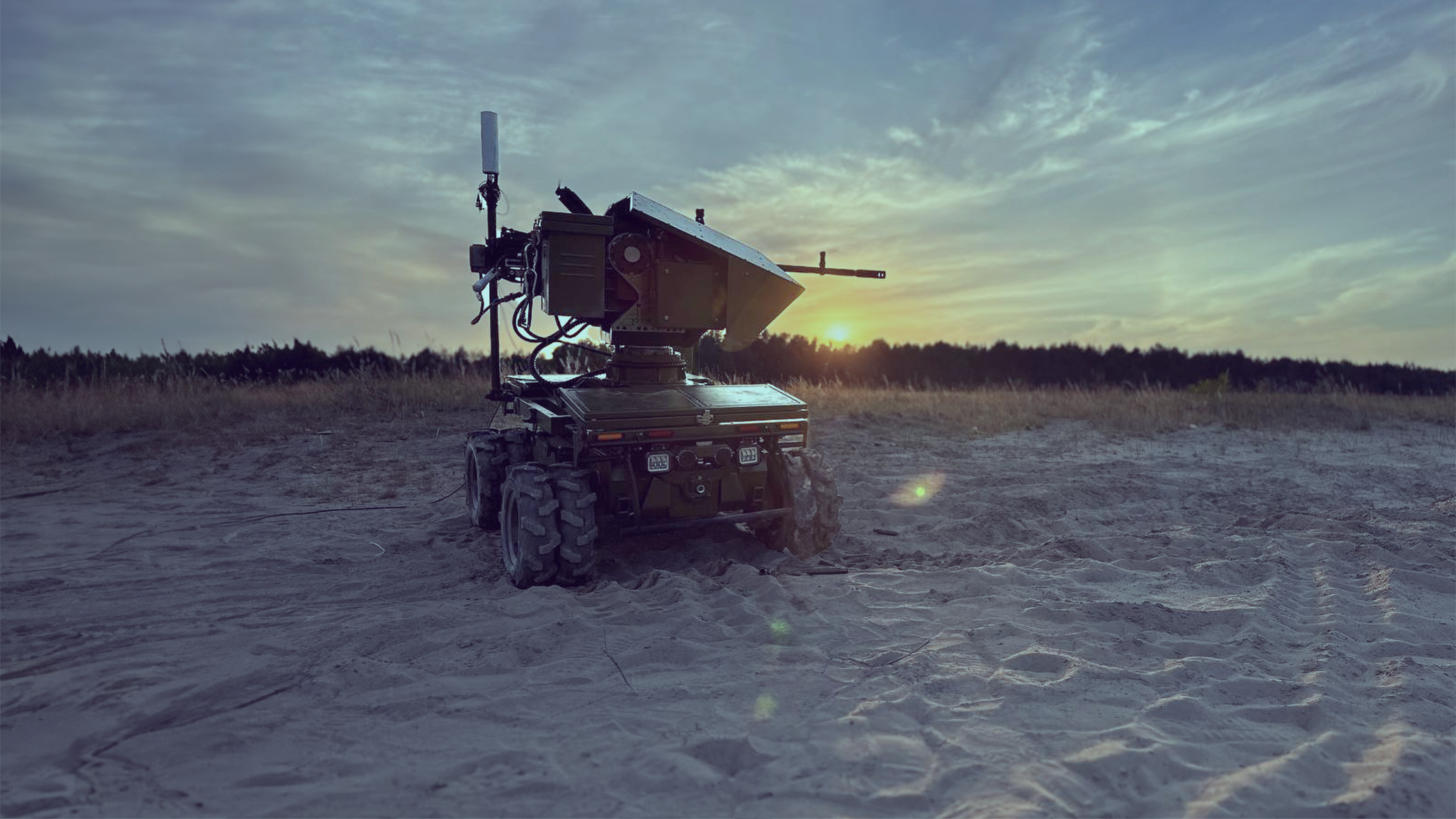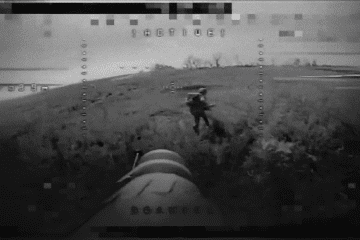- Category
- War in Ukraine
The Time For Killer Robot Warfare in Ukraine Has Come

Technology is the bedrock of modern warfare and Ukrainians are the pioneers of advanced tech on the battlefield. 2024 is a big year for rolling out robotic systems on the frontline, so what are they, and what do they do?
Since the full-scale invasion in February 2022, we’ve seen huge advancements in Unmanned Aerial Vehicles (UAVs), with drone usage becoming fully integrated into the Ukrainian Armed Forces. Eyes in the sky have become key to both offensive and defensive operations. Still, the giant fleet of UAVs used by both Ukraine and Russia enhances the vulnerability of those fighting on the ground, making them easy targets.
With fighting still fierce on the frontline, Ukraine seeks to minimize human loss and enhance the army’s effectiveness by further evolving its armament with Unmanned Ground Vehicles (UGVs)—the time for killer robots has come.
The D-21-11 UGV is an innovative system that can assist assault units in various ways, supporting them with reconnaissance, offensive, and defensive operations. Its native Ukrainian producers and manufacturers say it’s ready for action on the frontline.
We went to the frontlines to see Ukrainian forces training to use it effectively. Like with every new system, understanding and learning how to use it is essential in a combat environment. Any mistake can have huge consequences, from losing the robot in the best case to losing human life in the worst.
So, what does it do?
The D-21-11 is a versatile machine that can be reworked from a transport system to a weapon system in just a few minutes while directly on the frontline. Its most important feature—as with all UGVs—is that it can be operated remotely, minimizing the use of military personnel.
Machine Gun: A machine gun can be loaded onto the system within minutes. It has an automatic turret and can be operated remotely by the machine gunner.
Evacuations: It can evacuate dead or wounded directly from the zero line. Normally, it would take another 3 to 6 military personnel to evacuate their teammate, not only depleting numbers on the front, but also putting those evacuating in danger of attack from UAVs. The wounded soldier can also be easily replaced, as the D-21-11 can also work as a frontline taxi.
Supplies: Delivering ammunition, water, food and other provisions is normally a dangerous task. This robot can deliver anything its able to carry directly to those that need it without endangering more lives.
Reconnaissance: UAVs have been very successful in surveillance and reconnaissance missions; however enemy lines can be concealed in amongst the treelines. Eyes on the ground allows the military to seek enemy positions.
This UGV can travel for around 15/20 km on extremely rough frontline terrain, according to military personnel who we spoke to. The route took all day due to difficult driving conditions, and the battery on the robot was still alive.
The D-21-11 has already been successfully tested and has received positive feedback from the military. Developers plan to integrate NATO types of weapons into it, strengthen its resistance to enemy anti-aircraft missiles and are already working on scaling its production, said the Minister of Digital Transformation of Ukraine Mykhailo Fedorov.
UGVs are just starting to be used in large numbers, with the war still as deadly as when the full-scale began, robots—like the D-21-11—are set to provide some much-needed relief for the Armed Forces of Ukraine, where many soldiers are now well into their third year of full-scale war.
“Russia will feel the wrath of domestic production.”
Though the Ukrainian defence sector has drastically and impressively improved, troops have often found themselves outgunned while waiting and relying on the delivery of Western weaponry and budget. Therefore, the Ukrainian government budgeted nearly $1.4 billion in 2024 to buy, produce, and develop weapons domestically—20 times more than before Russia's full-scale invasion. Most of this budget has been allocated to UGV production.
Zelenskyy vowed that Russia would feel the “wrath of domestic production”.
According to Ukraine's Ministry of Defence, ‘Ukrainian-made products are dominating the ground robot systems’ as of June 2024.
The D-21-11 was launched by Brave1, created by Ukraine’s Government. It’s a united coordinational platform for Defence Tech to facilitate collaboration projects and has recently focused on advancing UGV capabilities.
“UGVs will become the next game changer in this war,” said Nataliia Kushnerska, Chief Operating Officer of Brave1. Our main goal is to minimize human participation on the battlefield.” More than 140 unmanned ground vehicles have been submitted for evaluation to the platform, and more than 50 have already been tested.
How are UGVs used so far?
This month, June 2024, another domestically produced UGV—also part of the Brave1 fleet—the ‘Skylab Sirko-S1’ ground drone was launched to reinforce the 6th Battalion of the Azov Brigade. Its main operations are cargo transportation, evacuation of wounded, and reconnaissance.
The domestically produced Ratel-S UGV—also created by Brave1—was used to blow up a bridge, preventing advancement from the enemy. Another video shows a Ukrainian UGV loaded with explosives detonating under a road overpass, reportedly in Russian-occupied territory.
Several UGVs—foreign and domestic—-are working Ukraine’s frontlines in various capacities, from demining efforts to reconnaissance and defense. Footage has captured some delivering ammunition to Ukrainian forces; some not only de-mine but can robotically lay mines, too.
Russian weapons have been recovered by Ukrainian UGVs, enabling the military to study their use of weaponry in the hopes of developing further countermeasures against them.
In April 2024 a video circulated from the 23rd Separate Riffle Battalion of the 63rd Brigade approaching Russian trenches with a kamikaze ground drone charge blasting their positions.
Russia is also beginning to roll out UGVs on the frontlines and has claimed to have produced the “first kamikaze FPV (first-person view) ground drone.” Depesha and Buggy are two robotic systems designed to hit targets by charge blasting.
UGVs clearly have many positive assets in assisting military units on the zero line, most importantly reducing the loss of life. However, they aren’t exempt from attacks and elimination by UAVs and are therefore pricey. Human life comes at a far greater cost.
UAVs are far cheaper, at just a few hundred dollars, though they are mostly used in one-way missions, whereas UGVs are for long-term use. The recent allocation of the Ukrainian Government's budget and support of defense tech collaboration platforms have provided the opportunity to develop and drive production.
Though both are improving their ground armament, Brave1 claims that their UGV systems already surpass Russia’s arsenal in quantity and quality, equipping the Ukrainian army with the tools to defend effectively while minimizing human loss. They said “By the end of 2024, the use of UGVs will become a systematic part of our military actions to repel Russian aggression.”

-46f6afa2f66d31ff3df8ea1a8f5524ec.jpg)

-29a1a43aba23f9bb779a1ac8b98d2121.jpeg)

-24deccd511006ba79cfc4d798c6c2ef5.jpeg)


